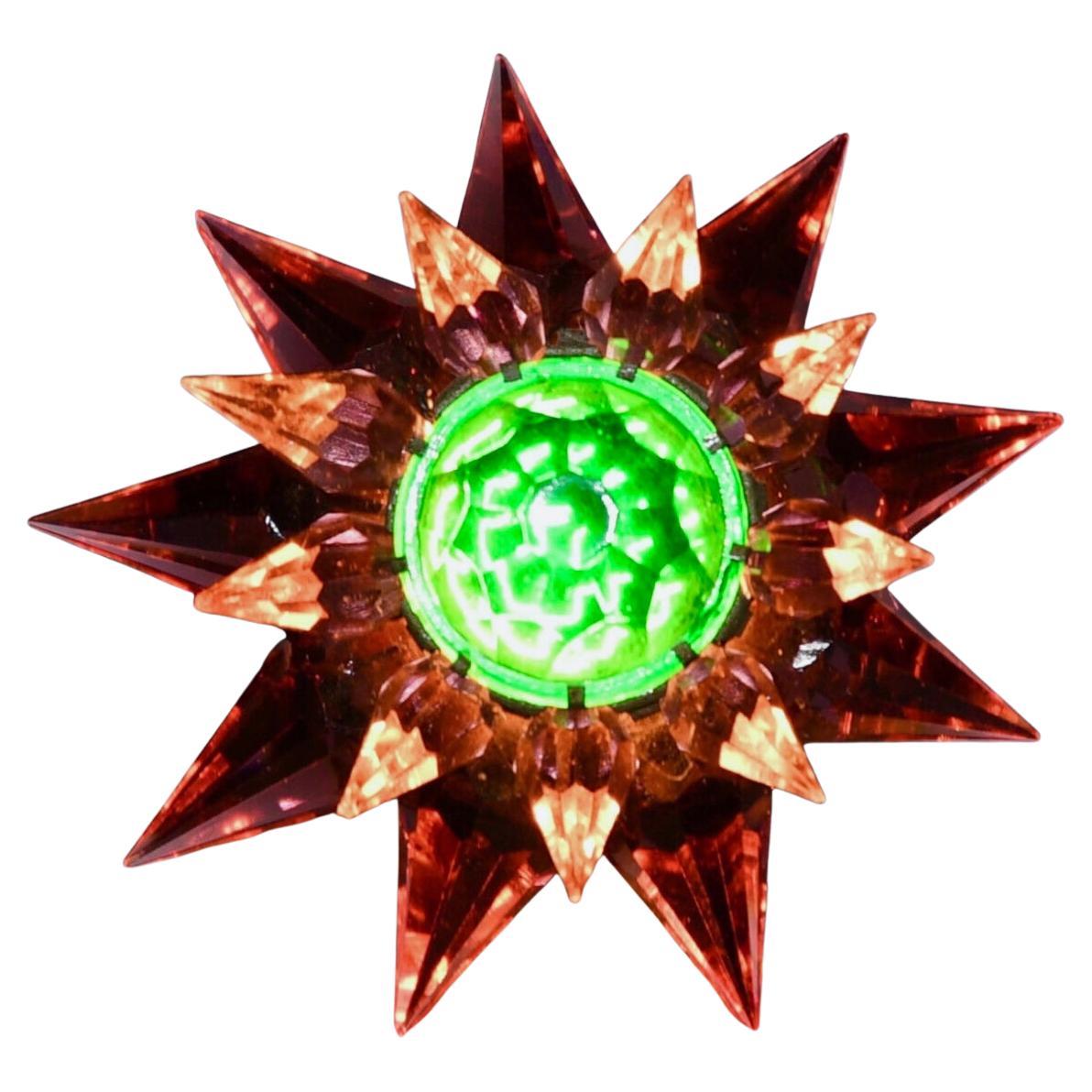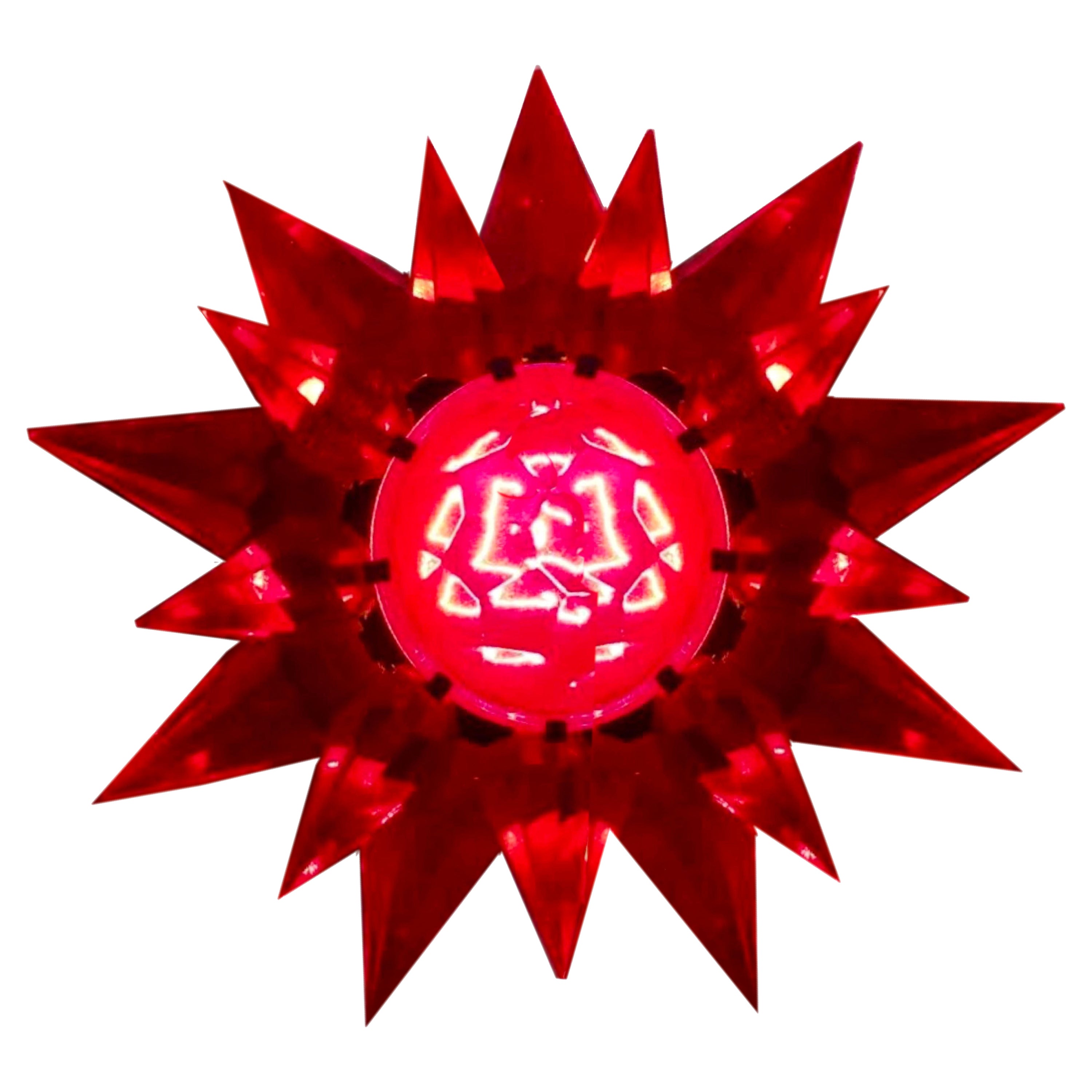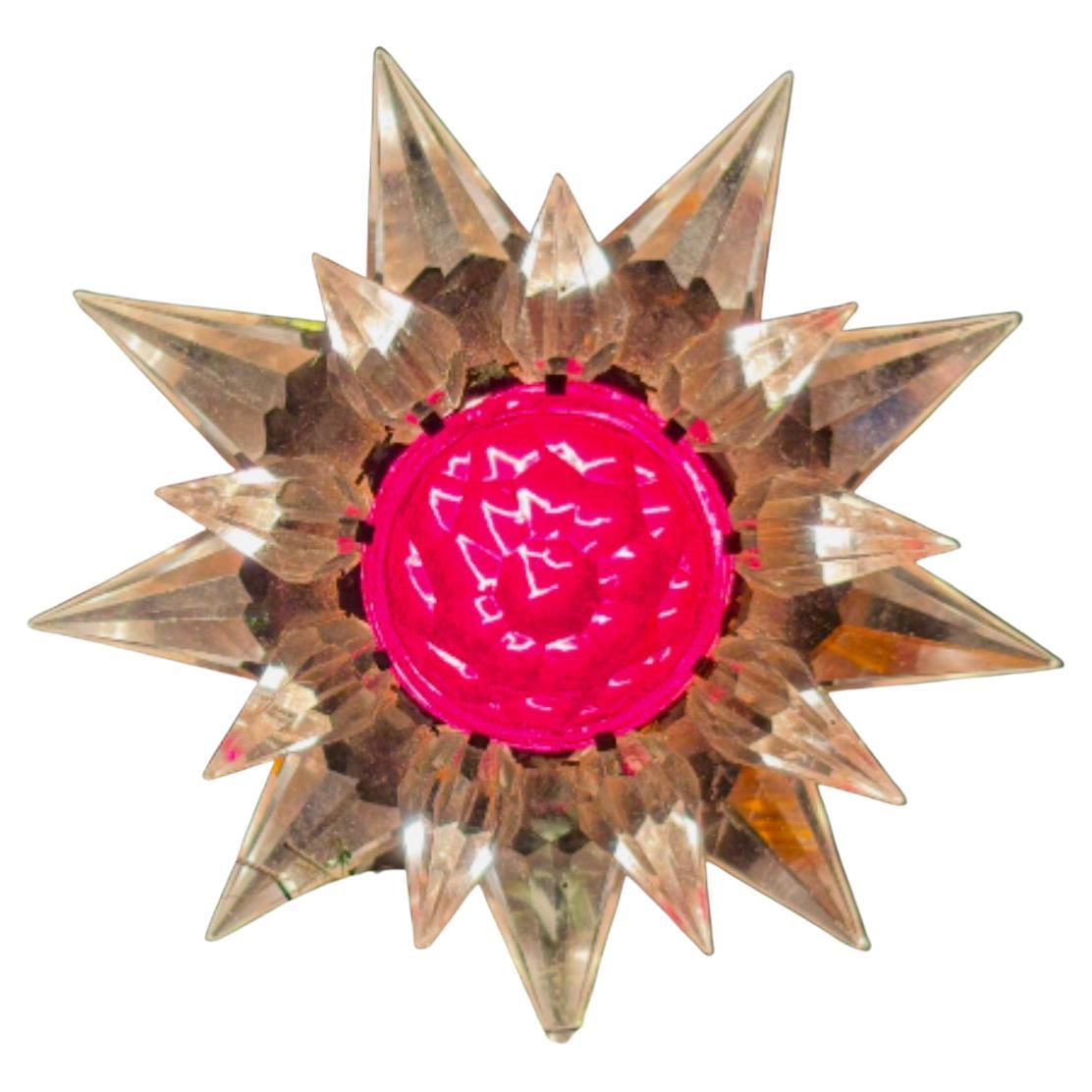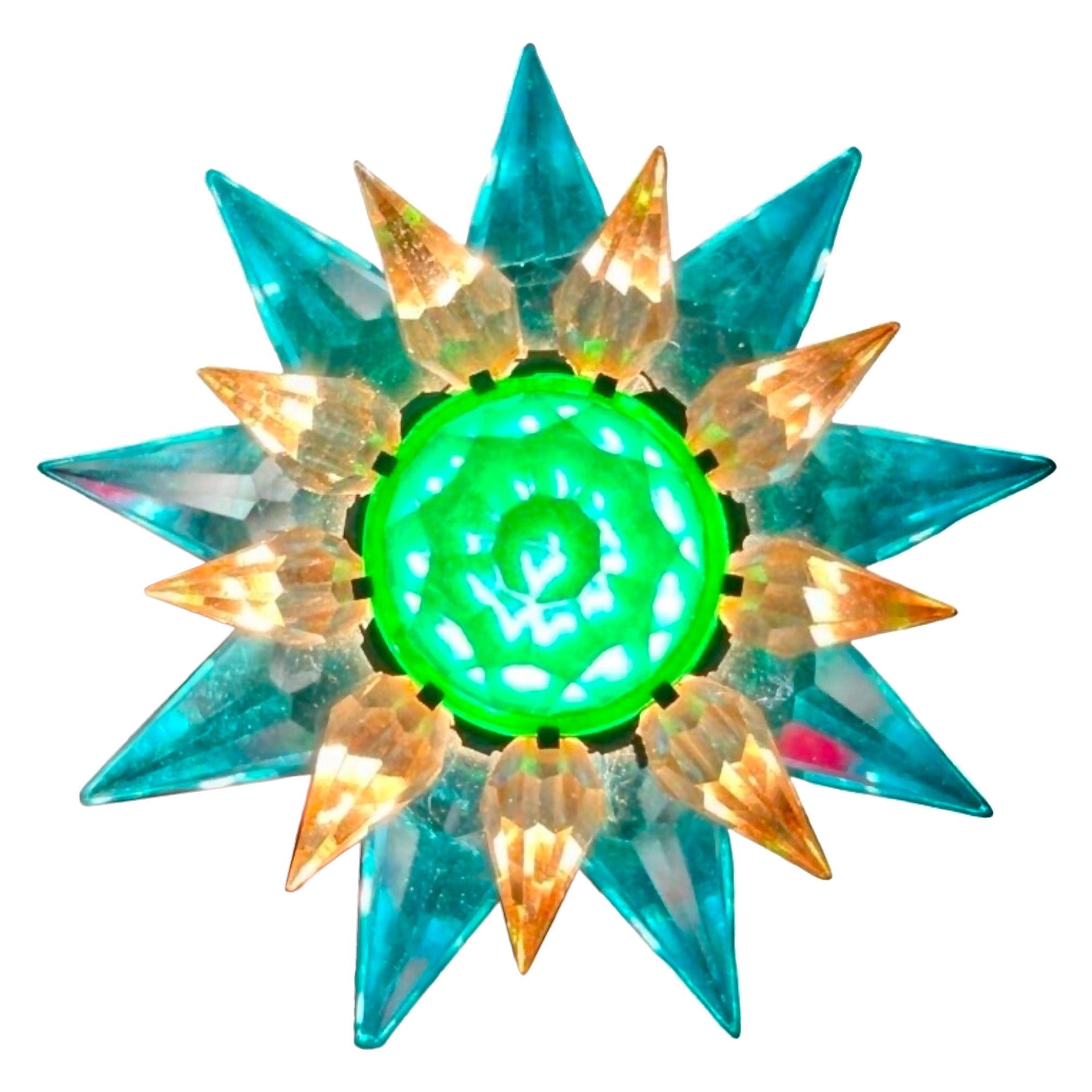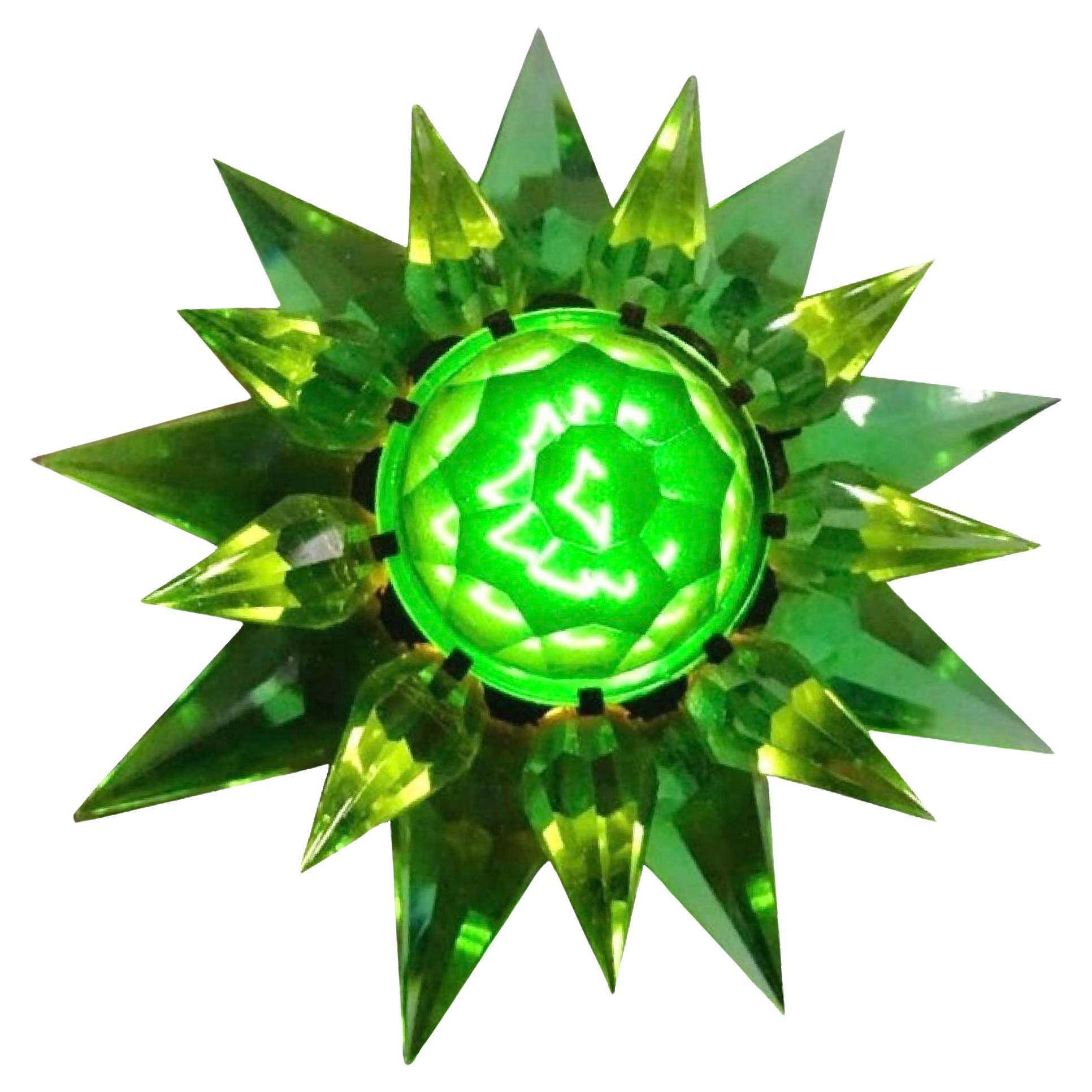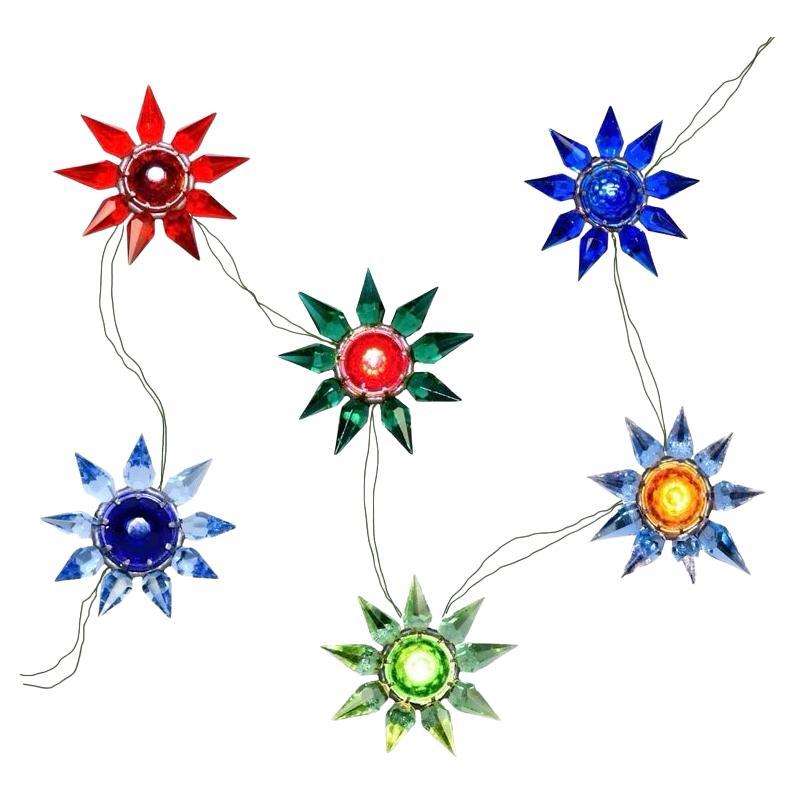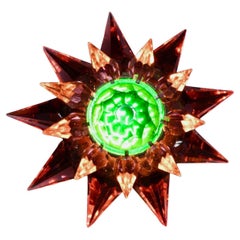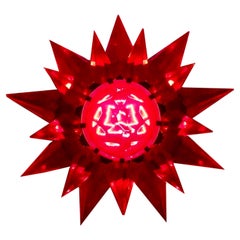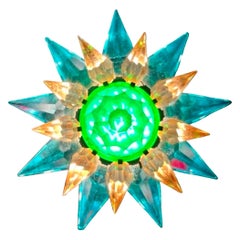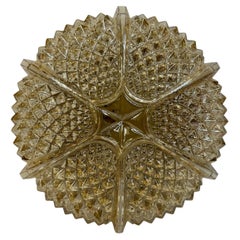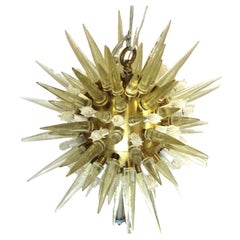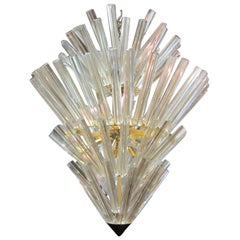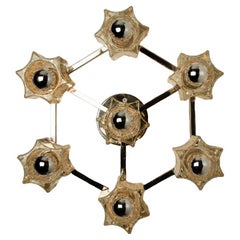Items Similar to Matchless Wonder Star #910 Double Row Amber & Blue Crystal C-9 Holiday Bulb 1936
Video Loading
Want more images or videos?
Request additional images or videos from the seller
1 of 13
Matchless Wonder Star #910 Double Row Amber & Blue Crystal C-9 Holiday Bulb 1936
$4,290
£3,235.09
€3,741.53
CA$6,018.85
A$6,690.32
CHF 3,506.92
MX$81,705.03
NOK 43,781.92
SEK 41,190.62
DKK 27,925.71
About the Item
Matchless Wonder Star #910 Double Row Amber & Blue Crystal C-9 Holiday Bulb, 1936. Extremely rare early crystal production in the rarely seen Amber points with blue sapphire center.
On May 2, 1935 Paul C. Dittman of Chicago filed an application for a patent for what he called simply "Decorative Lighting Device". In the patent he described it as "an ornamental device embodying a multiplicity of of prismatic light diffusing bodies with a light source..."
He related that while he was aware that others had patented lighted stars, his offering was different in that the light would enter the rays of the star radially, effectively refracting the light within the ray and producing a "pleasing effect."
His description of the refracted light produced by the stars was a bit of an understatement, as anyone who has seen them illuminated can attest: a lighted Matchless Wonder Star is stunningly beautiful. His patent was granted on December 8, 1936.
Paul Dittman, a German immigrant who passed through the gates of Ellis Island in New York City, worked for a time for George Westinghouse, where he got an education in the manufacturing of electric light bulbs. In 1912, Paul and his partners started the Matchless Electric Company, which was later incorporated (in 1918) "to manufacture, buy, sell and deal in electric supplies, light bulbs and radio tubes..." By 1930, the direction of the Company had changed a bit, and it was re-named The Century Lamp and Tube Company to reflect the fact that it was by this time the largest single licensee for the manufacture of RCA radio tubes. In addition to the tubes, the Company produced a large variety of small light bulbs, mainly miniature lamps that were used as indicators in telephone switch boards and various control panels, and automobile lamps as well. These lamps, an example of which is pictured below, are round, miniature based style with outside painted colors. These was even a Matchless brand set of Christmas lights available, which was a typical series string of eight cone shaped lamps.
In 1929, Mr. Dittman was the principle stockholder of a company incorporated as the D-G Electric Company, whose business was "to deal in all kinds and descriptions of electrical devices..." By 1931, the Company was renamed The Matchless Electric Company, and in 1934 the Century Lamp and Tube Company was dissolved.
The Matchless Electric Company of Chicago, Illinois made and sold these glass-prismed Christmas lights starting in about 1935, and continuing through the late 40s.The production of the Stars was a seasonal business for The Matchless Company, but Jim Dittman, inventor Paul's son, reports that the Stars were "my father's pride and joy." They were available in several sizes and many color combinations, and the glass points were made and hand cut in Czechoslovakia from authentic Austrian crystal. The lights were assembled and boxed in the United States. The earliest of these lights had a small paper label on one of the glass prisms, with "Made in Czechoslovakia" printed on it. The sticker was a bit confusing, as it referred only to the glass points and not the entire Star. During most of the year, the Company produced their regular stock of sewing machine, auto, radio pilot, aviation and instrument miniature lamps.
After World War II, the Company started selling their larger Stars made in Lucite instead of glass, as Communist occupation had cut off supplies of the needed Czechoslovakian crystal.
This page from a late 1930s hardware supply catalog features double Stars with various lamp sizes and color combinations. Also note the replacement lamps-something collectors would kill to get their hands on today, as the lamps with the bakelite backs have not been made for many years. Matchless Stars were some of the first Christmas lights offered with the ability to easily change the light bulb. NOMA had earlier offered their Dresden figural lights with changeable lamps, but the system was flawed and the socket parts froze together, making lamp exchange impossible.
Collectors who have researched these lights say that the Matchless Company did practically no advertising of this product, and references to the Stars can only be found in catalogs of the time. The 1939 and 1940 editions of Montgomery Wards Christmas catalogs feature them, and several hardware trade catalogs show the Stars. Matchless sold their Stars through the Marshall Fields stores as well. A major downside to these beautiful lights was their price-usually between 18 and 20 cents for a single row series 100 Star. While seemingly inexpensive in today's dollars, keep in mind that America was dealing with the effects of The Great Depression, and money was tight. An average Christmas tree of the time would feature between 40 and 48 miniature base series wired lights, and to fill the tree with Matchless Stars would have cost about $7.60. A typical boxed set of eight standard Christmas lights with the electrical cord sold for 65 cents in 1937, and a dozen eggs went for 12 cents. Spending almost $8.00 on Christmas lights was beyond the reach of many, so the Matchless Company wisely offered their Stars for sale singly as well as in sets of eight or ten.
The company offered their Stars in many different color combinations, with both clear and frosted crystals. The points were offered in red, green, aqua, steel blue, amethyst, pink, amber and clear. The center jewels were produced in red, green, amber and blue. Due to the Communist occupation of Czechoslovakia after World War II, the Matchless company found it difficult to obtain the proper quality glass crystals needed for the manufacture of their Stars. A redesign became necessary, and the larger Stars were then made in Lucite, and molded in one piece instead of individual points.
The piece available here is the largest and most rare of the Matchless Star production, #910 from series 900 (3.5” diameter). #910 featured a c-9 bulb, intermediate base. This is an authentic crystal version produced between 1936-1939. It comes with its original box. Original bulb. Working condition. Rare color combination. Ruby red central cut stone with gorgeous emerald green points. Double row.
- Dimensions:Height: 4 in (10.16 cm)Width: 3.5 in (8.89 cm)Depth: 3.5 in (8.89 cm)
- Style:Art Deco (Of the Period)
- Materials and Techniques:
- Place of Origin:
- Period:
- Date of Manufacture:1930s
- Condition:Wear consistent with age and use. Minor losses. Wear consistent with age and use. Minor losses. Minor fading. See photos. Good antique condition. Light surface wear possible. Bulb needs to be replaced.
- Seller Location:Brooklyn, NY
- Reference Number:1stDibs: LU4190339142842
About the Seller
5.0
Gold Seller
Premium sellers maintaining a 4.3+ rating and 24-hour response times
Established in 2017
1stDibs seller since 2018
656 sales on 1stDibs
Typical response time: 2 hours
- ShippingRetrieving quote...Shipping from: Brooklyn, NY
- Return Policy
Authenticity Guarantee
In the unlikely event there’s an issue with an item’s authenticity, contact us within 1 year for a full refund. DetailsMoney-Back Guarantee
If your item is not as described, is damaged in transit, or does not arrive, contact us within 7 days for a full refund. Details24-Hour Cancellation
You have a 24-hour grace period in which to reconsider your purchase, with no questions asked.Vetted Professional Sellers
Our world-class sellers must adhere to strict standards for service and quality, maintaining the integrity of our listings.Price-Match Guarantee
If you find that a seller listed the same item for a lower price elsewhere, we’ll match it.Trusted Global Delivery
Our best-in-class carrier network provides specialized shipping options worldwide, including custom delivery.More From This Seller
View AllMatchless Wonder Star #910 Rare Purple & Amber Crystal C-9 Holiday Bulb 1936
Located in Brooklyn, NY
Matchless Wonder Star #910 Double Row Purple & Amber Crystal C-9 Holiday Bulb, 1936. Extremely rare early crystal 900 series production in the rarely seen purple points with amber ce...
Category
Vintage 1930s American Art Deco Chandeliers and Pendants
Materials
Crystal
Matchless Wonder Star #910 Double-Row Red Crystal Holiday C-9 Bulb, USA, 1930s
Located in Brooklyn, NY
Matchless Wonder Star #910 Double-Row Red Crystal Holiday C-9 Bulb, USA, 1930s. Extremely rare early crystal production with original box.
On May 2, 1935 Paul C. Dittman of Chicago filed an application for a patent for what he called simply "Decorative Lighting Device". In the patent he described it as "an ornamental device embodying a multiplicity of of prismatic light diffusing bodies with a light source..."
He related that while he was aware that others had patented lighted stars, his offering was different in that the light would enter the rays of the star radially, effectively refracting the light within the ray and producing a "pleasing effect."
His description of the refracted light produced by the stars was a bit of an understatement, as anyone who has seen them illuminated can attest: a lighted Matchless Wonder Star is stunningly beautiful. His patent was granted on December 8, 1936.
Paul Dittman, a German immigrant who passed through the gates of Ellis Island in New York City, worked for a time for George Westinghouse, where he got an education in the manufacturing of electric light bulbs. In 1912, Paul and his partners started the Matchless Electric Company, which was later incorporated (in 1918) "to manufacture, buy, sell and deal in electric supplies, light bulbs and radio tubes..." By 1930, the direction of the Company had changed a bit, and it was re-named The Century Lamp and Tube Company to reflect the fact that it was by this time the largest single licensee for the manufacture of RCA radio tubes. In addition to the tubes, the Company produced a large variety of small light bulbs, mainly miniature lamps that were used as indicators in telephone switch boards and various control panels, and automobile lamps as well. These lamps, an example of which is pictured below, are round, miniature based style with outside painted colors. These was even a Matchless brand set of Christmas lights available, which was a typical series string of eight cone shaped lamps.
In 1929, Mr. Dittman was the principle stockholder of a company incorporated as the D-G Electric Company, whose business was "to deal in all kinds and descriptions of electrical devices..." By 1931, the Company was renamed The Matchless Electric Company, and in 1934 the Century Lamp and Tube Company was dissolved.
The Matchless Electric Company of Chicago, Illinois made and sold these glass-prismed Christmas lights starting in about 1935, and continuing through the late 40s.The production of the Stars was a seasonal business for The Matchless Company, but Jim Dittman, inventor Paul's son, reports that the Stars were "my father's pride and joy." They were available in several sizes and many color combinations, and the glass points were made and hand cut in Czechoslovakia...
Category
Early 20th Century American Art Deco Chandeliers and Pendants
Materials
Crystal
$1,439 Sale Price / item
20% Off
Matchless Wonder Star #910 Double Row Clear & Red Crystal C-9 Holiday Bulb, 1936
Located in Brooklyn, NY
Matchless Wonder Star #910 Double Row Clear & Red Crystal C-9 Holiday Bulb, 1936. Extremely rare early crystal production in clear points with red center.
On May 2, 1935 Paul C. Di...
Category
Vintage 1930s American Art Deco Flush Mount
Materials
Crystal
$1,176 Sale Price
59% Off
Matchless Wonder Star #910 Blue, Pink & Green Crystal C-9 Holiday Bulb 1936
Located in Brooklyn, NY
Matchless Wonder Star #910 Double Row Tricolor Light Blue, Pink & Green. Crystal C-9 Holiday Bulb, 1936. Extremely rare 900 series crystal production in rare three color combination....
Category
Vintage 1930s American Art Deco Chandeliers and Pendants
Materials
Crystal
Matchless Wonder Star #910 Double Row Green Crystal Holiday C-9 Bulb, USA, 1936
Located in Brooklyn, NY
On May 2, 1935 Paul C. Dittman of Chicago filed an application for a patent for what he called simply "Decorative Lighting Device". In the patent he described it as "an ornamental device embodying a multiplicity of of prismatic light diffusing bodies with a light source..."
He related that while he was aware that others had patented lighted stars, his offering was different in that the light would enter the rays of the star radially, effectively refracting the light within the ray and producing a "pleasing effect."
His description of the refracted light produced by the stars was a bit of an understatement, as anyone who has seen them illuminated can attest: a lighted Matchless Wonder Star is stunningly beautiful. His patent was granted on December 8, 1936.
Paul Dittman, a German immigrant who passed through the gates of Ellis Island in New York City, worked for a time for George Westinghouse, where he got an education in the manufacturing of electric light bulbs. In 1912, Paul and his partners started the Matchless Electric Company, which was later incorporated (in 1918) "to manufacture, buy, sell and deal in electric supplies, light bulbs and radio tubes..." By 1930, the direction of the Company had changed a bit, and it was re-named The Century Lamp and Tube Company to reflect the fact that it was by this time the largest single licensee for the manufacture of RCA radio...
Category
Vintage 1930s Flush Mount
Materials
Crystal
$1,616 Sale Price / item
20% Off
Matchless Wonder Star Single-Row Multicolor Crystal C-6 Set of Bulbs, USA, 1930s
Located in Brooklyn, NY
Matchless Wonder Star Single-Row Multicolor Crystal C-6 Set of Bulbs, USA, 1930s. Bulbs all working at this time. All in tact. Czech Crystal. Set includes light blue/cobalt, green/gr...
Category
Early 20th Century American Art Deco Chandeliers and Pendants
Materials
Crystal
You May Also Like
Beautiful Starburst Smoked Amber Glass Flush Mount, Vintage, 1960s
By Glashütte Limburg
Located in Nuernberg, DE
A beautiful German glass flush mount with metal fixture. The fixture requires one European E27 / 110 Volt Edison bulbs, up to 60 watt. It has ...
Category
Vintage 1960s German Mid-Century Modern Flush Mount
Materials
Metal
Mid Century /Modern Sputnik -Star Chandelier
Located in Los Angeles, CA
A one of a kind Custom Designed and Custom made Chandelier for an Interior Designer in Los Angeles . Never to be made again . Three years in the making with a 12" diameter center sph...
Category
2010s American Mid-Century Modern Chandeliers and Pendants
Materials
Acrylic
Murano Starburst Camer Glass Five-Tier Chandelier Mid-Century Modern
By Camer Glass
Located in Pemberton, NJ
Outrageous and large Mid-Century Modern Camer glass five-tier starburst chandelier. This piece is very large and impressive and will be the centerpiece of your home.
Category
Vintage 1970s Italian Mid-Century Modern Chandeliers and Pendants
Materials
Brass
$6,800 Sale Price
20% Off
Wonderful Star Flush Mount/ Wall Light Peill Putzler Crystal Glass, Germany
By Peill & Putzler
Located in Rijssen, NL
Exclusive Sputnik crystal glass flush mount/ wall light designed by Sciolari for Peil & Putzler, Germany, 1970s
Wonderful light effect.
Dimensions
D 17.3 "44 cm x H 6.2" 16 cm
Heav...
Category
Vintage 1970s German Mid-Century Modern Flush Mount
Materials
Chrome
Custom Austrian Snowflake Crystal Chandelier in Brass Finish
Located in New York, NY
Custom Austrian snowflake crystal chandelier. Custom order are available for different sizes and finishes.
Category
21st Century and Contemporary American Mid-Century Modern Chandeliers an...
Materials
Crystal, Metal, Brass
Antique Flush Mount Bronze and Glass Sunburst Chandelier
Located in New York, NY
Expertly designed and crafted flush-mount chandelier with sunburst motif including molded glass rays of light and swirling clouds in bronze with light brown patina, and original engr...
Category
Early 20th Century American Flush Mount
Materials
Bronze
More Ways To Browse
Christmas Star
Dresden Blue
Light Blue Star Sapphire
Amber Jewel
Vintage Bakelite Switches
1930 Radio
Pink Crystal Lamps
Pink Star Ruby
1930s Vintage Radio
Aqua Lights
Czechoslovakia Crystal
Orange Bakelite
Austrian Christmas
Glass Christmas Tree
Crystal 1930 Lamps
German Vintage Radios
File Box
Pink Lucite Furniture
